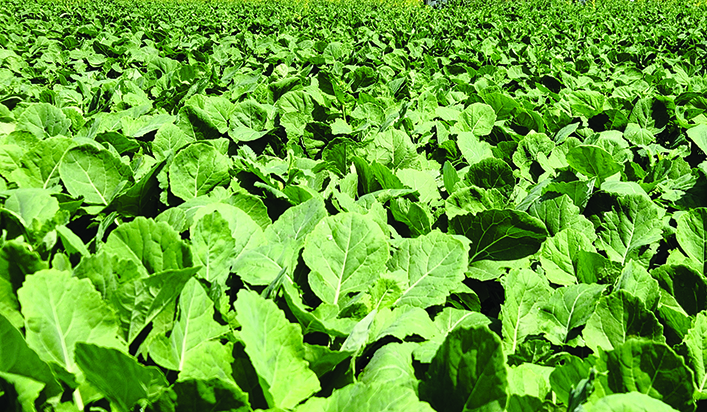It has been a rollercoaster ride for canola futures in 2023.
The year started out on a high, with nearby futures trading at $838 per tonne.
LeftField Commodity Research analyst Chuck Penner advised growers attending the Saskatchewan Canola Development Commission’s annual general meeting in January to wait out the market.
Other stories in the 2023 Canola Yearbook:
- Decent yields in dry times
- Canola views – photo essay
- Canola growing season in review
- Spraying in dry times can be tricky
- Flying the fields
- Hormone imbalance suspected for malformed racemes
- Incorporating resistant traits weighs on yields
- Production briefs
- Pest roundup: Canola pests kept in check by dry conditions
- Disease roundup: Verticillium has breakout year
- Canola news briefs
- Canola growers scramble to address federal policy issues
- What happens when the big crop comes?
“There is some pretty good upward potential for canola in the next few months,” he said, noting that supplies of the crop were tight.
Farmers were coming off a 2022 harvest that was the lowest since 2015, excluding the 2021 drought crop.
He was forecasting strong domestic demand and good export sales to markets like China.
Penner noted that the seasonal tendency was for canola to reach its market highs in the April-through-June period.
But that did not occur.
December futures tumbled in early March, reaching a low of $621 per tonne on May 31.
Ken Ball, canola analyst with PI Financial, spoke to The Western Producer in late-March about the downturn.
“We’re seeing an exit of money from the long side of the market over the last month or so,” he said.
“A lot of that money just decided, for maybe a number of reasons, meh, it’s time to go away and do something else.”
One of the main reasons was that the Australian government issued a March crop report forecasting a record 8.27 million tonnes of canola production in 2022-23, shattering the previous record of 6.82 million tonnes set the year before.

Prices rebounded in June after Agriculture Canada issued its 2023-24 Canadian production estimate of 18.4 million tonnes, only slightly larger than the previous year’s disappointing 18.17 million tonnes.
“I’m surprised how low their projection is,” said Ball in a late-May interview.
The trade had been anticipating a crop in excess of 20 million tonnes.
He noted that there was strong domestic demand shaping up for the new crop in addition to a perkier outlook for exports.
“Through all this winter we’ve had to battle that monster Australian crop,” said Ball.
“The odds are fairly high Australia won’t be able to repeat that kind of a crop.”
That turned out to be prescient. The Australian government’s September forecast calls for 5.15 million tonnes of production in 2023-24, a 38 percent drop.
The market also got a boost from a United States Department of Agriculture forecast calling for 5.95 billion pounds of U.S. canola oil imports in 2023-24, a 450-million-lb. increase over the previous year.
“The growing domestic demand for canola oil can, in part, be attributed to the (Environmental Protection Agency’s) recently adopted canola oil pathway for renewable diesel production,” the USDA stated in its Oil Crops Outlook: May 2023 report.
Prices steadily climbed, peaking at $836 per tonne on July 19, which is close to where they started the year.
Plunging European rapeseed prices made it difficult for canola to rally higher. That was a function of rapeseed oil becoming the cheapest of all the vegetable oils in the European Union.
“I have never seen that before,” MarketsFarm analyst Mike Jubinville said in an early-June interview.
“That is very unusual and certainly it has had an impact on European rapeseed prices.”
European rapeseed futures lost 31 percent of their value between the start of the year and the end of May as European analysts started forecasting a big domestic crop in 2023-24 to go along with a large carryout from the previous year.
FEDIOL, a European vegetable oil and protein meal lobby group, also said rapeseed oil prices were under “abnormal pressure” from a massive increase in imported waste biodiesel made from used cooking oil and animal fats.
Canadian canola futures remained above the $800-per-tonne level until the beginning of September when they took another downward spiral.
That is around the time that reports came out forecasting that Ukraine would harvest a record 4.5 million tonnes.
The premium of Canadian canola futures over European rapeseed futures reached “extraordinarily wide levels.”
“We’re not going to ship to Europe, and we haven’t for the past year or two,” said Jubinville.
Prices kept falling in September despite a Sept. 14 Statistics Canada report that dropped Canadian production another one million tonnes, to 17.4 million tonnes.
MarketsFarm analyst Bruce Burnett said in September that the drop was due to “normal harvest pressure” and slumping global vegetable oil prices.
But he remained optimistic about the fall outlook because of robust domestic demand for the crop triggered by “very high” crush margins.
Burnett was forecasting strong export demand as well, following a year of unexpectedly large purchases from China.
He said he was going to monitor palm oil production in Indonesia and Malaysia because it could be down due to El Nino. That would also bolster prices.
Jubinville also sounded bullish about canola in the fall outlook presentation he delivered on Oct. 26.
He advised growers to hold off on selling the crop until prices climb another $1 per bushel.
He told farmers he believes nearby canola futures have bottomed out at around $700 per tonne due to harvest pressure and are likely to experience a bounce in the coming months.
MarketsFarm anticipates robust demand for the crop from both the domestic and export markets this year, resulting in about 1.45 million tonnes of carryout at the end of 2023-24.
“That is still a fairly tight scenario here that we’re proposing,” said Jubinville.
His one big caveat is that China is expected to account for about half of the anticipated 7.5 million tonne export program, and he is a little nervous about that market.
“China so far this year has been oddly sluggish in terms of contracting Canadian canola supply,” he said.
He thinks that is because Russia and China are becoming allies and trading partners, with Russia suddenly shipping 75,000 to 100,000 tonnes of rapeseed oil per month to China.
China is also importing canola from Australia and Ukraine, so there is plenty of competition in that market.
Another bearish factor for the canola market is the lingering cheap European rapeseed prices caused by the flood of Ukrainian imports resulting from this year’s big crop in addition to large carryout supplies from the previous year.
But Jubinville still believes that strong demand prospects will eventually lift Canadian prices in the coming months.
Canadian canola was reasonably priced at a $35 to $40 per tonne premium over soybeans at the time of Jubinville’s Oct. 26 presentation. The normal premium is in the $50 to $100 range.
The long-term outlook for canola is promising because of the U.S. Environmental Protection Agency approving the crop as a feedstock for its burgeoning renewable diesel sector.
That is expected to result in a massive new market canola and was one of the main drivers for the plethora of new crushing plant announcements for the Canadian Prairies.
Farm Credit Canada said those new builds and expansions would result in 7.8 million tonnes of new crush capacity if all the projects are completed.
That seems excessive given that the Canadian Oilseed Processors Association is forecasting that the entire North American renewable fuels sector will consume the equivalent of 3.9 million tonnes of canola by 2025 and 6.5 million tonnes by 2030.
It appears that the U.S. renewable diesel sector may have gotten ahead of itself, because of the EPA’s disappointing final rule on its renewable fuel mandates for the next three years.
The EPA announced in June that it was setting its biomass-based diesel obligations at 2.82 billion gallons for 2023, 3.04 billion gallons for 2024 and 3.35 billion gallons for 2025.
The renewable fuel and oilseed sectors had been anticipating far bigger mandates.
COPA executive director Chris Vervaet said at the time that the EPA’s final numbers were a disappointment for his member companies.
“This is really a missed opportunity in the short and medium term,” he said.

“It dampens the demand signal, there is no doubt about it.”
Rabobank senior analyst Owen Wagner recently stated that the EPA’s disappointing announcement has created a glut of renewable diesel in the U.S. market in 2023, putting downward pressure on U.S. soybean oil futures prices.
But analysts are still generally bullish about the prospects for canola going forward due to demand from the renewable diesel sector, even if it will not be as robust as initially anticipated.
Domestic crush demand is already outstripping export demand by a wide margin.
Jubinville is forecasting 10.5 million tonnes of Canadian crush demand versus 7.5 million tonnes of export demand in 2023-24. Just a few years ago, it was a 50-50 split.
Farmers are benefiting from that shift to increased local demand for their crop.
“The North American crusher does have the highest propensity to pay for canola seed,” he said. ✤
Contact sean.pratt@producer.com


















